自考英语词汇学串讲1~6+补充串讲 合并版
英语词汇学教程全套课件精选文档

VS
Common suffixes include "ness", "- tion", "- ism", "- ment", "- ity", etc.
Root word
Root word is the basic form of vocabulary, usually a monosyllabic word that can be used independently. For example, "act" is a root word that can add different prefixes and suffixes to form other words, such as "action", "react", "activate".
The Importance of English Lexicology
English Lexicology is crucial for language learners because it helps them understand the meaning and usage of words, improving their vocabulary and language comprehension
It is a branch of linguistics that focuses on the vocabulary of a specific language, providing a systematic and comprehensive understanding of words and their meanings
英语词汇学自考重点
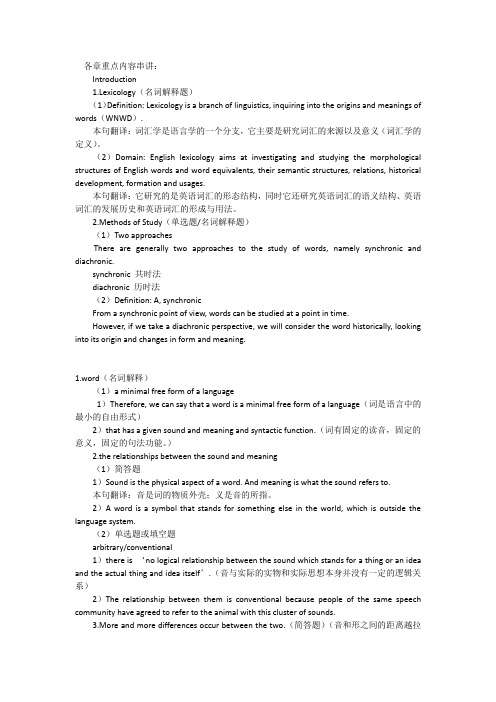
各章重点内容串讲:Introduction1.Lexicology(名词解释题)(1)Definition: Lexicology is a branch of linguistics, inquiring into the origins and meanings of words(WNWD).本句翻译:词汇学是语言学的一个分支,它主要是研究词汇的来源以及意义(词汇学的定义)。
(2)Domain: English lexicology aims at investigating and studying the morphological structures of English words and word equivalents, their semantic structures, relations, historical development, formation and usages.本句翻译:它研究的是英语词汇的形态结构,同时它还研究英语词汇的语义结构、英语词汇的发展历史和英语词汇的形成与用法。
2.Methods of Study(单选题/名词解释题)(1)Two approachesThere are generally two approaches to the study of words, namely synchronic and diachronic.synchronic 共时法diachronic 历时法(2)Definition: A, synchronicFrom a synchronic point of view, words can be studied at a point in time.However, if we take a diachronic perspective, we will consider the word historically, looking into its origin and changes in form and meaning.1.word(名词解释)(1)a minimal free form of a language1)Therefore, we can say that a word is a minimal free form of a language(词是语言中的最小的自由形式)2)that has a given sound and meaning and syntactic function.(词有固定的读音,固定的意义,固定的句法功能。
英语词汇学复习提纲
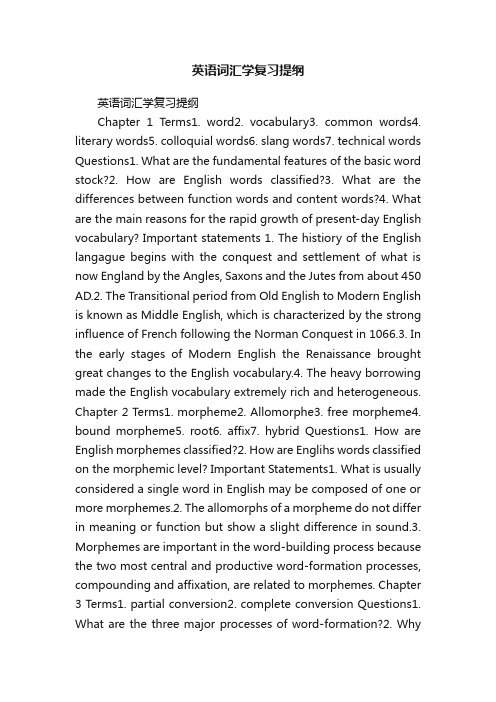
英语词汇学复习提纲英语词汇学复习提纲Chapter 1 Terms1. word2. vocabulary3. common words4. literary words5. colloquial words6. slang words7. technical words Questions1. What are the fundamental features of the basic word stock?2. How are English words classified?3. What are the differences between function words and content words?4. What are the main reasons for the rapid growth of present-day English vocabulary? Important statements 1. The histiory of the English langague begins with the conquest and settlement of what is now England by the Angles, Saxons and the Jutes from about 450 AD.2. The Transitional period from Old English to Modern English is known as Middle English, which is characterized by the strong influence of French following the Norman Conquest in 1066.3. In the early stages of Modern English the Renaissance brought great changes to the English vocabulary.4. The heavy borrowing made the English vocabulary extremely rich and heterogeneous. Chapter 2 Terms1. morpheme2. Allomorphe3. free morpheme4. bound morpheme5. root6. affix7. hybrid Questions1. How are English morphemes classified?2. How are Englihs words classified on the morphemic level? Important Statements1. What is usually considered a single word in English may be composed of one or more morphemes.2. The allomorphs of a morpheme do not differ in meaning or function but show a slight difference in sound.3. Morphemes are important in the word-building process because the two most central and productive word-formation processes, compounding and affixation, are related to morphemes. Chapter 3 Terms1. partial conversion2. complete conversion Questions1. What are the three major processes of word-formation?2. Whyare the criteria of a compound relative? Important Statements1. There are varioius ways of forming words, but by and large, the various processes can be classified on the basis of frequency of usage, into major or minor processes.2. Any rule of word formation is of limited productivity in the sense that not all words which result from the applicationn of the rule are acceptable; they are freely acceptable only when they have gained an institutional currency in the language.3. Prefixes modify the lexical meaning of the base. They do not genearlly alter the word-class of the base.4. Suffixes usually change the word-class of the base. Chapter 4 Terms1. blending2. back-formation3. clipp ing4. neoclassical formation Questions1. What are the differences between initialisms and acronyms? Important Statements1. On the whole, clipped words are used in less formal situations than their full-length equivalents.2. Most of the blends are related to daily life.3. The majority of backformed words are verbs.4. Reduplicatives are characterized by being rhymed or alliterated.5. The majority of neoclassical formations are scientific and technical.6. Genuine coinage is rare.7. Some new words are coined by analogy. Chapter 5 Terms1. motivation2. denotative meaning3. connotative meaning4. stylistic meaning5. affective meaning Questions1. What is the relationship between word form and its senses?2. What are the main types of word meaning? Important Statements1. The test of a genuinely onomatopeic word is its intelligibility to a foreigner who has no knowledge of the language in question.2. Denotative meaning is the central factor in linguistic communication.3. Lexical meaning is dominant in content words, whereas grammatical meaning is dominant in funciton words. Chapter 6 Terms1. radiation2. concatination3. prima ry meanin4. central meaning5. perfect homonyms6.homophones7. homographs Important Statements1. One-meaning words are very rare. They are very often scientific terms.2. It may be said that polysemy is the rule and monosemy is the exception.3. In some cases, the primary meaning and the central meaning coincide.4. Polysemic words and homonymous words are not only good candidates for humor, they can also produce other effects such as irony or heightened dramatic power. Chapter 7Terms1. complete synonyms2. relative synonyms3. hyponymy4. marked member5. unmarked member Questions1. In what respects do synonymous words differ? Important Statements1. An agreement in denotation is the most important criterion of synonymy.2. Two words aretotally synonymous only if they are fully identical in meaning and interchangeable in any context without the slightest alteration in connotative, affective and stylistic meanings.3. It is important to note that two forces militate against complete synonymy: vagueness of word meaning,and connotative, stylistic and affective meanings that cluster around words.4. In most cases the native word is more spontaneous, more informal and unpretentious, whereas the foreign word is learned, abstract or even abstruse.5. In the double scale pattern of synonyms the native term usually sounds warmer and more homely than its foreign counterpart.6. In the triple scale pattern of synonyms the difference in tone between the English and the French words is often slight; the Latin word is generally more bookish.7. Synnonyms are useful for avoiding repetition and for achieving precision in meaning and variety in style.8. Lexical antonymy is often stronger than syntactic negation.9. This semantic category obviously overlaps with hyponymy: both are involved with forming relaionships between words in the same general area ofmeaning. For parctical purposes, in the case of hyponymy, one should pay attention to the question of which specific term to use, while in the case of semantic field, one’s attention should be turned toward the highly probable collocations the words of each semantic field have in common. Chapter 8 Terms1. linguistic context2. ambiguity Questions1. What are the different types of context?2. What are the functions of context in determination of word meaning? 3. What are the different types of ambiguity? Important Statements1. When we say that the context determines the sense we mean not that it imposes a sense but that it selects one that is already there.2. Words rarely can be equated on a one-to-one basis between two languages. Chapter 9 Terms1. historical cause of changes in word meaning2. social cause of changes in word meaning3. linguistic cause of changes in word meaning4. psychological cause of changes in word meaning5. metaphor6. metonymy Questions1. What are the mian causes of changes in word meaning?2. What are the tendencies in semantic change? Important Statements1. Usually a literal meaning of a word remains along with a new metaphorical one.2. Broading speaking, change of meaning refers tothe alteration of the meaning of existing words, as well as the additionnn of new meaning to established words. Chapter 10Terms Idiom Question What points should we attention to if we want to use idioms appropriately? Chapter 11 Questions1. What are three stages in the growth of American English?2. What are the characteristics of American English? Chapter 12Terms1. prescriptive dictionaries 2. descriptive。
自考英语词汇学复习大纲自己整理

11 C h a p t e r 1 B a s i c C o n c e p t s 基本概念 1.1 the definition of a word(he definition of a word comprises the following points: (1) a minimal free form of a language; (2) a sound unity; (3) a unit of meaning; (4) a form that can function alone in a sentence. A word is a minimal free form of a language that has a given sound and meaning and syntactic function.)1.2 sound and meaning :symbolic connection is almost always arbitrary and conventional. A dog is called a dog not because the sound and the three letters that make up theword just automatically suggest the animal in question.1.3 sound and form :1.4 vocabulary 1.5 classification of words 词汇分类 basic word stock 基本词汇 nonbasic vocabulary 非基本词汇 by use frequency 按使用频率分: basic word stock and nonbasic vocabulary 基本词汇和非基本词汇 by notion 按概念分: content words and functional words 实义词和功能词 by origin 按起源分: native words and borrowed words 本地词和外来词 all national character 全民性 stability 稳定性 productivity 多产性 p ol ysemy 一词多义 collocability 搭配性 terminology 术语 jargon 行话 slang 俚语 argon 黑话 dialectal words 方言词 archaism 古语词 neologism 新词 neutral in style 文体上中性frequent in use 使用频繁native words本地词borrowed words外来词denizens 同化词aliens 异形词translation-loans 译借词semantic-loans 借义词1. No enough letters: alphabet from latin2. Pronunciation changed more rapidly3. Early scribes: change spelling for easier recognition4. Borrowing: different rules of pronunciation and spelling obvious characteristics 明显的特点22C h a p t e r 2D e v e l o p m e n tIt is assumed that the world has approximately 3, 000 (some put it 5, 000 ) languages, which can be grouped into roughly 300 language families on the basis of similarities in their basic word stock and grammar. 2.1 Indo-European 印欧语Eastern set : 东部诸语族: Western set : 西部诸语族: Balto-Slavic 波罗的海-斯拉夫语 Indo-Iranian 印度-伊朗语 Armenian 亚美尼亚语 Albanian 阿尔巴尼亚语 Celtic 凯尔特语 Italic 意大利语Hellenic 希腊语 ——GreekGermanic 日耳曼语Persian 波斯语 Bengali 孟加拉国语 Hindi 印地语 Romany 普吉赛语 Prussian 普鲁士语Lithuanian 立陶宛语 Polish 波兰语 Czech 捷克语 Bulgarian 保加利亚语 Slovenian 斯洛文尼亚语 Russian 俄语 Portuguese 葡萄牙语 Spanish 西班牙语 French 法语 Italian 意大利语 Roumanian 罗马尼亚语Scottish 苏格兰语 Irish 爱尔兰语 Welsh 威尔士语 Breton 布里多尼语 Latin 拉丁语言2.2 Historical review历史概述2.3 Growth of Present-day English VocabularyNorwegian 挪威语Icelandic 冰岛语Danish 丹麦语Swedish 瑞典语German 德语Dutch 荷兰语Flemish 佛兰德语English 英语Scandinavian languages斯堪的纳维亚语50000-60000 words 5万~6万间词汇Highly inflected 高度转折complex endings 复杂的结尾vowel changes 元音变化French words 法语词汇leveled endings 水平结尾Early Modern English (1500-1700)早期现代英语Late Modern English (1700-up to the present)晚期现代英语Borrow 借词new words 新词no endings 无结尾from a synthetic language (Old English) to the present analytic language。
自考《英语词汇学》复习资料第6章
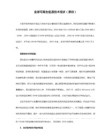
Of the 5 meanings 1) is the primary and all the rest are derived but each of the other four is directly related to 1). Therefore, we say neck has developed through the process of radiation.
a season’s yield of grain or fruit
Pain penalty or punishment pains and penalty
upon/under pain of suffering
Synchronic approach – synchronically, polysemy is viewed as the coexistent of various meaning of the same word in a certain historical period of time. The basic meaning of a word is the core of word meaning. The core of word meaning called the central meaning (secondary meaning).
e.g. The word “flight” may mean “passing through the air”, “power of flying”, “air of journey”, etc.
Two approaches(识记)
Diachronic approach – Diachronically, polysemy is assumed to be the result of growth and development of the semantic structure of one and same word. This first meaning is the primary meaning. With the advance of time and the development of language, it took on more and more meanings. These latter meanings are called derived meanings. E.g. face
《英语词汇学》串讲笔记1

13. Content words are changing all the time whereas functional words are stable.14. In Old English there was more agreement between sound and form.15. A word is a symbol that represents something else in the world.form. But their meanings are borrowed. In other words, English has borrowed a new meaning foran existing word in the language11. argot(黑话): It generally refers to the jargon of criminals.12. content words(实词): Content words denote clear notions including nouns, verbs, adjectives, adverbs and numerals.13. terminology(术语): Terminology consists of technical terms used in particular disciplines and academic areas.14. native words(本族语): Native words, also known as Anglo-Saxon words, are words brought to Britain in the 5th century by the German tribes.论述问答题:1. With the development of the Language, why do more and more differences occur between the Sound and Form?答:It is generally agreed that the written form of a natural Language is the written record of the oral form. But with the development of the Language, more and more differences occur between them, the reasons are as follows:①. The internal reason for this is that the English alphabet was adopted from the Romans, which does not have a separate letter to represent each sound in the Language so that some letters must do double duty or work together in combination.②. Another reason is that the pronunciation has changed more rapidly than spelling over the years, and in some cases the two have drawn far apart.③. A third reason is that some of the differences were created by the early scribes.④. Finally comes the borrowing, which is an important channel of enriching the English vocabulary. When English borrowed words from other Languages , it borrowed spelling as well.2. What are the obvious characteristics of the words of the basic word stock(基本词汇)?①. All national character.(全民性)②. Stability(稳定性)③. Productivity(多产性)④. Polysemy(多义性)⑤. Collocability(搭配性)Of course, not all the words of the basic word stock have these characteristics. Pronouns and numerals enjoy nation-wide use and stability, but are semantically monosemous and have limited productivity and collocability. Therefore, ‗all national character‘is the most important of all features that may differentiate words of common use from all others.3. Apart from the characteristics mentioned of the basic word stock, in contrast to borrowed words, native words have two other features, what are they?答:①. Neutral in style(文体上中性). Since native words denote the commonest things in human society, they are used by all people, in all places, on all occasions, and at all times. Therefore, they are not stylistically specific.②. Frequent in use(使用频繁). Native words are most frequently used in everyday speech and writing. The proportion of its use in relation to borrowings is perhaps just the opposite of its number.4. Illustrate the relationship between sound and meaning with examples.答:A word is phonetic symbol that stands for something in the world. This symbolic connection is almost always arbitrary, and there is ‗no logical relationships between the sound which stands for a things or an idea and the actual thing and idea itself‘. For example, woman is represented by the sound Frau in German, femme in French, and funv in Chinese.5. Explain neologisms(新词语)with examples.答:Neologisms are newly created words or expressions, or words that have taken on new meanings. For example, ―emil‖(electronic mail, the sending of messages via computer systems) is a word newly coined against the background of rapid development in information technology. The word ―mouse‖ might examplify the words taking on new meanings : now a mouse is indispensable for computer users.6. How are English words generally classified? Elaborate on it.答:V ocabulary can be classified by different criteria into different types.①By use frequency(使用频率), words may fall into the basic word stock(基本词汇)and nonbasic vocabulary(非基本词汇). Basic vocabulary is small in number but forms the core of the language and enjoys the high frequency of use. Nonbasic vocabulary contains such words as terminology, jargon, which have a relatively limited use;②By notion(实义), words can be divided into content words(实义词)and functional words(功能词即虚词), content words have clear notions such as nouns, verbs. Functional words cover prepositions, articles, conjunctions, etc, whose major functions are to help make sentences;③By origin(起源), words can be grouped into native words(本族语词)and borrowed words(外来语词). Native words refer to the words of Anglo-Saxon origin, which are small in number but form the main stream of basic word stock. Borrowed words are words taken over from other languages and make up 80%of the whole English vocabulary. These three criteria are the most widespread and popular. There are other ways too, for example, by morphological structure, formality, emotionality, and so on.Chapter 2The Development of the English Vocabulary一、【考情分析】16. Modern English(当代英语)began with the establishment of printing(印刷术)inEngland.2. What are the causes of more new words appearing today?答:the rapid development of modern science and technology.;inflectional affixes, derivational affixes.12. The plural morpheme ‗s‘ is realized by /s/ after the sounds /t, p, k/ and by /z/ after /d, b, g, l/in a compound like ―handcuff‖. It can be a root morpheme plus one or more affixationalmorphemes as in ―mouthful‖. Therefore, a stem can be defined as a form to which affixes of any kind cab be added.2. Analyze the morphological structure of the following words in terms of free morpheme and bound morpheme, then explain the differences between the two kinds of morphemes.UnhappilyIdealistic答:①Each of two words consists of three morphemes:unhappily(un+happy+ly), idealistic(ideal+ist+ic).②―happy‖ and ―ideal‖ are free morphemes; un-, -ly, -ist and –ic are bound morphemes.③free morphemes have complete meanings in themselves and can be used as free grammatical units in sentences. Bound morphemes must be bound to other morphemes to form words.3. Analyze the morphological structures of the following words and point out types of the morphemes. recollection, nationalist, unearthly.答:recollection, nationalist, unearthly1) Each of the three words consists of three morphemes:recollection(re+collect+ion), nationalist(nation+al+ist), unearthly(un+earth+ly).2) Of the nine morphemes, only ―collect‖―nation‖ and ―earth‖ are free morphemes as they can exist by themselves.3) All the rest are bound morphemes as none of them can stand alone as words.。
(完整word版)自考英语(二)串讲讲义
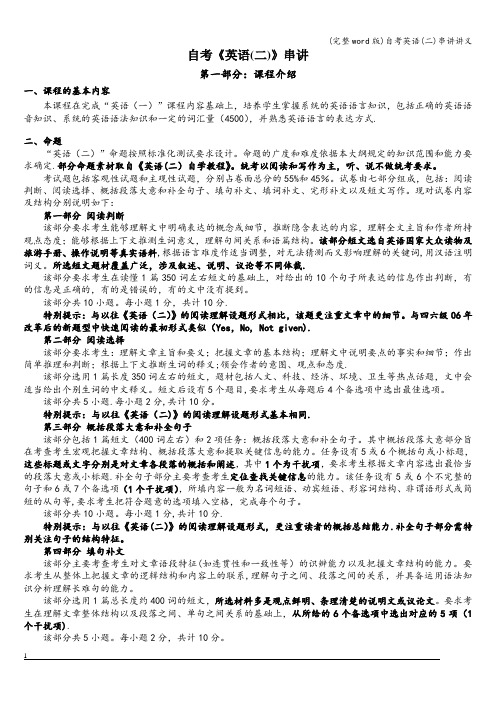
自考《英语(二)》串讲第一部分:课程介绍一、课程的基本内容本课程在完成“英语(一)”课程内容基础上,培养学生掌握系统的英语语言知识,包括正确的英语语音知识、系统的英语语法知识和一定的词汇量(4500),并熟悉英语语言的表达方式.二、命题“英语(二)”命题按照标准化测试要求设计。
命题的广度和难度依据本大纲规定的知识范围和能力要求确定.部分命题素材取自《英语(二)自学教程》。
统考以阅读和写作为主,听、说不做统考要求。
考试题包括客观性试题和主观性试题,分别占卷面总分的55%和45%。
试卷由七部分组成,包括:阅读判断、阅读选择、概括段落大意和补全句子、填句补文、填词补文、完形补文以及短文写作。
现对试卷内容及结构分别说明如下:第一部分阅读判断该部分要求考生能够理解文中明确表达的概念或细节,推断隐含表达的内容,理解全文主旨和作者所持观点态度;能够根据上下文推测生词意义,理解句间关系和语篇结构。
该部分短文选自英语国家大众读物及旅游手册、操作说明等真实语料,根据语言难度作适当调整,对无法猜测而又影响理解的关键词,用汉语注明词义。
所选短文题材覆盖广泛,涉及叙述、说明、议论等不同体裁.该部分要求考生在读懂1篇350词左右短文的基础上,对给出的10个句子所表达的信息作出判断,有的信息是正确的,有的是错误的,有的文中没有提到。
该部分共10小题。
每小题1分,共计10分.特别提示:与以往《英语(二)》的阅读理解设题形式相比,该题更注重文章中的细节。
与四六级06年改革后的新题型中快速阅读的最初形式类似(Yes,No, Not given).第二部分阅读选择该部分要求考生:理解文章主旨和要义;把握文章的基本结构;理解文中说明要点的事实和细节;作出简单推理和判断;根据上下文推断生词的释义;领会作者的意图、观点和态度.该部分选用1篇长度350词左右的短文,题材包括人文、科技、经济、环境、卫生等热点话题,文中会适当给出个别生词的中文释义。
英语词汇学串讲9
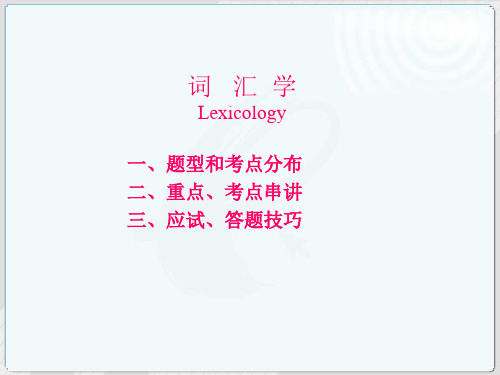
1.2. Sound and Meaning
The relation between sound and meaning is not logical, but arbitrary and conventional.
出题形式:选择, 填空,定义。
2002年
9.The term "vocabulary" is used in different ways because of all the following reasons EXCEPT that( )
A. it can refer to the common core of a language B. it can refer to the total number of the words in a language C. it can represent all the words used in a certain historical period D. it can stand for words in given dialect or field
1.3. Sound and Form
English sound is an imperfect representation of the spoken form.
(1) in English there are more phonemes than letters. (2) The pronunciation has changed more rapidly than spelling
Woman (English) Frau ( German) femme (French ) funu ( Chinese)
自考英语二串讲(最新版)

英语二串讲主讲:李佳其更多优质自考资料尽在百度贴吧自考乐园俱乐部(/club/5346389)欢迎加入...欢迎交流...止不住的惊喜等着你.........目录•第一讲 课程说明•第二讲 重点知识讲解回顾•第三讲 题型精析,答题策略•与千万自考生同行,你准备好了吗?•自考乐园h t t p://t i e b a.b a i d u.c o m/c l u b/5346389•自考学习、交流、资料共享的好去处!•我们自考人自己的家园!一起成..•第一讲课程说明•英语(二)是高等教育自学考试全国统考课程之一,即将进行的英语二的考试,根据考试大纲的说明,将继续沿用以往的题型,考查学生词汇、语法的掌握情况和阅读、翻译等语言运用能力。
命题题型、分值、难度和效度都将与以往试题保持整体上的一致,基本上不做变化。
考试采用闭卷笔答形式,限时150分钟。
试卷由试题册、答题卡和答题纸组成,所有答案均须按要求填写在答题卡和答题纸上。
试题由客观题和主观题构成,各占50%,试题题量以中等水平的考生能在规定的时间内答完全部试题并有适量时间检查答案为度。
评分采用百分制,60分为及格。
试卷结构如下表:151Translation from E into CVII15566-70Translation from C into E VI 101056-65Word form V 102036-55Word spelling IV 301521-35Reading comprehensionIII 101011-20ClozeII 10101-10Vocabulary and StructureI 分值题量题号名称部分•串讲目的:•通过对课程重点内容的整理概括、知识点的梳理总结,着重讲解考点,分析难点。
同时分析考试命题趋势,指导学生答题方法,提示学生考前复习计划,目的是帮助应试者通过本课程考试,达到考试要求。
本次串讲重点讲述:•重点词汇、短语:大纲要求考生能够认知3943个单词,熟练掌握2000个常用词即重点词汇,考试高频词;•重点、难点句子详解:教材课文中一些句子含有较多、较集中的知识点或者句子结构很复杂包含了多重语法现象,需要给同学们单独列出讲解;一些句子不易理解,包含了英语中的不常见用法,需要给同学们提示;通过分析这些句子强化考点,同时提高同学们的语言应用能力;•考题举例:讲解知识点的同时,通过分析历年考题,强化了知识点,并使学生了解命题的方向、范围、难度;•题型分析、答题策略:分析试卷的7大考题题型,逐一提出考查的知识点、出题来源、复习重点、答题方法和答题时间;•复习计划和考情交流:分析考试命题趋势,提示学生考前复习计划;•参考教材:《大学英语自学教程下册》,高远主编,高等教育出版社•参考资料:《英语(二)自学考试大纲》,全国高等教育自学考试指导委员会制订,高等教育出版社出版第二讲 重点知识讲解回顾Unit 1•重点单词和短语•objective accomplish predict accompany attain scheme skilled argue define•interview prospect•course of action in the way(by the way, in no way, in a way) make a guess at contribute to and the like (and so on)•seek to do sth. in part point of view vary from…to …•apply for (to)•have no idea bring about take the trouble to do•put oneself in one’s place•to one’s advantage at a disadvantage ask for in hand turn down (up, on, off, out, over, back)•重点、难点句子详解• 1.A decision is a choice made from among alternative courses of action that are available.解析:courses of action意思是行动方案、做事步骤;made是过去分词;from among为二重介词•例:We’ll inform you as soon as tickets become _____. (06-4)A. valuableB. capableC. acceptableD. available (D)• 2. … some suggest that the management process is decision making.解析:suggest表示认为、提出、暗示意思,后面不用虚拟语气,表示建议意思,后面用虚拟语气。
[英语考试]高等教育自学考试英语词汇学第一章到第八章必背考点
![[英语考试]高等教育自学考试英语词汇学第一章到第八章必背考点](https://img.taocdn.com/s3/m/f7329d204028915f804dc2ef.png)
• English, Latin and French existed side by side. • Middle English was one of leveled endings.
• 3 Modern English Period (1500-now):
vocabulary
• Vocabulary --- all the words in a language make up its vocabulary .
• The general estimate of the present-day English vocabulary is over 1 million words.
Non-basic vocabulary --
• (1)Terminology(术语) • (2)Jargon(行话) • (3)slang(俚语) • (4)Argot(暗语) • (5)Dialectal words(方言) • (6) Archaisms(古语) • (7) Neologisms(新词语)
• Morpheme(词素)---the minimal meaningful unit of a language.
3.3 types of morphemes
• Free morphemes (自由词素) • Bound morphemes (粘附词素)
• a free morpheme refers to a morpheme that can stand alone.
• bound morpheme refers to a morpheme that accurs with at least one other morpheme.
自考英语词汇学 第二章课件教学提纲

2.4 Modes of Vocabulary Development词汇 发展的模式
❖ Modern English vocabulary develops through three channels: creation, semantic change, borrowing. 现代英语词汇的发展主要通过三个渠道: 创词、旧词新义和借词。
当时拉丁语和希腊语被认为是西方世界灿烂文学遗产的语言是学术语言真空干燥又名解析干燥是一种将物料置于负压条件下并适当通过加热达到负压状态下的沸点或着通过降温使得物料凝固后通过溶点来干燥物料的干燥方式
英语词汇学
Chapter 2 The development of the
English Vocabulary 英语词汇的发展
❖ In the early period of Modern English, Europe saw a new upsurge of learning ancient Greek and Roman classics. This is known in history as the Renaissance. 在早期现代英语阶段,欧洲掀起了学习希腊 和罗马的古典著作的运动。这场运动史称文 艺复兴。
growth of English vocabulary though quite insignificant. 复活古词和废弃词对整 个英语词汇来说虽然影响不大,但却是一种 发展方式。
自考《英语词汇学》复习资料

自考《英语词汇学》复习资料第一章以下是我整理的英语词汇学的资料。
我在考的时候主要就是靠这个东东。
希望对还没有过的人有所帮助。
大家请注意:笔记中大多数是以名词解释的形式出现的,这些是绝对的基础,应该一字不漏的背下来。
其实不少简答题也就是几个定义的汇总,再加上个例子就可以拿满分了。
区分两个词的区别,主要还是指明其各自的定义。
第一章1. Word ——A word is a minimal free form of a language that has a given sound and meaning and syntactic function.2. There is no logical relationship between sound and meaning as the symbolic connection between them is arbitrary and conventional. E.g. “woman” means ’Frau’ in German,’Femme’ in French and ’Funv ’in Chinese. On the other hand,the same sound /rait/ can mean right,rite and write,though denoting different things,yet have the same sound.3. The difference between sound and form result from 4 major factors.(At least 80%of the English words fit consistent spelling patterns)a). the internal reason is English alphabet does not have a separate letter to represent each sound in the language.b). Pronunciation has changed more rapidly than spellingc). Influence of the work of scribes/printing freezes the spelling of words in 1500d). Borrowing of foreign language4. V ocabulary —— V ocabulary is most commonly used to refer to the sum total of all the words of a language. It can also refer to all the words of a given dialect,a given book,a given subject and all the words possessed by an individual person as well as all the words current in a particular period of time in history.The general estimate of the present day English vocabulary is over 1 million words.5.Classification of Words—by use frequency,by notion,by origin1). Basic word stock – the foundation of the vocabulary.1. all national character (most important)– natural phenomenamost common things and phenomena of the human body and relationsworld around us names of plants and animalsaction,size,domain,statenumerals,pronouns,prep. ,conj.2. stability –they donate the commonest thing necessary to life,they are like to remain unchanged. Only relative,some are undergoing some changes. But the change is slow.e.g. arrow,bow,chariot,knight – pastelectricity,machine,car,plane —— now3. productivity –they are mostly root words or monosyllabic words,they can form new words with other roots and affixes.e.g. foot – football,footage,footpath,footer4. polysemy – often possess more than one meaning. Become polysemous.e.g. take to move or carry from one place to anotherto remove5. collocability – quite a number of set expressions,idiomatic usages,proverbial saying and otherse.g. heart – a change of heart, a heart of goldNon-basic vocabulary ——1. terminology – technical termsphotoscanning,hepatitis,indigestion,penicillin,algebra,trigonometry,calculus2. jargon – specialized vocabulary in certain professions.Bottom line,ballpark figures,bargaining chips,hold him back,hold him in,paranoid3. slang —— substandard words often used in informal occasionsdough and bread,grass and pot,beaver,smoky,bear,catch,holler,Roger,X-rays,Certain words are labeled slang because of their usage.4. argot – words used by sub-cultured groupscan-opener,dip,persuadercant,jargon ,argot are associated with,or most available to,specific groups of the population.5. dialectal words – only by speakers of the dialectbeauty,chook,cocky,station,auld,build,coo,hame,lough,bog6. archaisms – words no longer in common use or restricted in use. In older poems,legal document and religious writing or speech.7. neologism – newly created words with new meaning e.g. microelectronics,futurology,AIDS,internet,E-mailold meaning acquired new meaning e.g. mouse,monitor2). Content word (notional word)– denote clear notions.Functional word (empty word,form word)– do not have notions of their own,express the relation between notions,words and sentences.a. Content words constitute the main body of the English vocabulary are numerous.Functional words are in a small number.b. Content words are growing.Functional words remain stable.c. Functional words do far more work of expression than content words.3). Native words –are words brought to Britain in the 15 century by the German tribes. Ango-Saxon Words,50,000-60,000What is true of the basic word stock is also true of native world. More are1. neutral in style (not stylistical specific )2. 2.frequent in use (in academic fields and science French,Latin or Greek are used)(usage 70-90%)Borrowed words (loan words,borrowing)– words taken over from foreign language. 80%According to the degree of assimilation and manner of borrowing,we can bring the loan words under 4 classes.1.Denizens – words borrowed early and now are well assimilated into English language.e.g. port from portus(L)shift,change,shirt,porkcup from cuppa(L)2.Aliens – retained their original pronunciation and spellinge.g. décor(F)blitzkreeg(G)emir,intermez,rowtow,bazaar,rajar,status quo3.translation loans – formed from the existing material in the English language but modeled on the patterns taken from another language.1). Word translated according to the meaninge.g. mother tough from lingua maternal(L)black humor from humor noirlong time no see,surplus value,master piece2). Words translated according to the sounde.g. kulak from kyrak(Russ)lama from lama(Tib)ketchuptea4. Semantic loans – their meaning are borrowed from another languagee.g. stupid old dumpnew sassydream old joy and peacepioneer old explorer/person doing pioneering worknew a member of the young pioneerfresh old impertinent,sassy,cheeky自考《英语词汇学》复习资料第二章第二章Indo-European language family (Europe,the Near East,India)Balto –Slavic Indo-Iranian Italic GermanicPrussian Persian Portuguese NorwegianLithuanian Hindi Spanish IcelandiePolish Italian DanishBulgarian Roumanian SwedishSlovenian French EnglishRussian GermanAlbanian Armenian Celtic HellenicIrish GreekBretonScottish2. History (时间,历史事件,特征)1)Old English (450-1150)totally 50,000-60,000 wordsThe 1st people known to inhabit England were Celts,the language was Celtic.The second language was the Latin of the Roman Legions.The Germanic tribes called angles,Saxons and Jutes and their language,Anglo-Saxondominated and blotted out the Celtic. Now people refer to Anglo-Saxon as old English.At the end of 6th century,the introduction of Christianity has a great impact on the English vocabulary.The common practice was to create new words by combining two native words.In the 9th century,many Scandinavian words came into English. At least 900 words of Scandinavian are in modern English,our daily life and speech.特点:highly inflected languagecomplex endings or vowel changes (full ending)2)Middle English (1150-1500)English,Latin,FrenchUntil 1066,although there were borrowings from Latin,the influence on English was mainly Germanic. But the Norman Conquest started a continual flow of French words into English.By the end of the 13th century,English gradually come back into public areas.Between 1250 and 150 about 9000 words of French origin come into English. 75% of them are till in use today.As many as 2500 words of Dutch origin come into English.特点:fewer inflectionsleveled ending3)Modern English (1500-up to now)early modern English (1500-1700)late modern English(1700-up to now)The Renaissance,Latin and Greek were recognized as the languages of the Western world’s great literary heritage.The Industrial Revolution was in the mid-17 century. With the growth of colonization,British tentacles began a stretching out of to every corner of the globe,thus enabling English to absorb words from all major languages of the world.After World War II,many new words have been created to express new ideas,inventions and scientific achievements.More words are created by means of word-formation.thousands and thousands of new words have been entered to express new ideas inventions,and scientific achievements.more words are created by means of word-formation.in modern English,word endings were mostly lost with just a few exceptions English has evolved from a synthetic language to the present analytic language.science and technology terms make up about 45% of new words. words associated with life-style constitute of 24% and social and economic terms amount to over 10% .mention should be made of an opposite process of development i.e. old words falling out if use.特点:ending are almost lost.3. Three main sources new words1.The rapid development of modern science and technology2.Social,economic and political changes3.The influence of other cultures and languages4. Three modes of vocabulary development1. Creation – the formation of new words by using the existing materials,namely roots,affixes and other elements. (This is the most important way of vocabulary expansion.)2. Semantic change - an old form which take on a new meaning to meet the new need.3. Borrowing – to take in words from other languages.(particularly in earlier time)4. (Reviving archaic or obsolete)French 30%,Latin 8%,Japanese Italian 7%,Spanish 6%,German Greek 5%,Russian Yiddish 4%自考《英语词汇学》复习资料第三章第三章1. Morpheme —— A morpheme is the smallest meaningful unit of a language. (The smallestfunctional unit in the composition of words.)2.Morph—— A morpheme must be realized by discrete units. These actual spoken minimal carriers of meaning are morphs.3.Monomorphenic words – morphemes are realized by single morphs.4.Allomorph——Some morphemes are realized by more than one morph according to their position. Such alternative morphs are allomorphemes. E.g. the morpheme of plurality (-s)has a number if allomorphemes in different sound context,e.g. in cats/s/,in bags/z/,in matches/iz/.5. Free morphemes or Free root —— The morphemes have complete meaning and van be used as free grammatical units in sentences,e.g. cat,walk. They are identical with root words. morphemes which are independent of other morphemes are considered to be free.6. Bound Morphemes —— The morphemes cannot occur as separate words. They are bound to other morphemes to form words,e.g. recollection (re+collect+ion)collect – free morpheme re-and –ion are bound morphemes. (include bound root and affix)Bound morphemes are found in derived words.7. Bound root ——A bound root is that part of the word that carries the fundamental meaning just like a free root. Unlike a free root,it is a bound form and has to combine with other morphemes to make words. Take -dict- for example:it conveys the meaning of “say or speak” as a Latin root,but not as a word. With the prefix pre-(=before)we obtain the verb predict meaning “tell beforehand”。
自考英语词汇学

自考英语词汇学一、基本概念。
1. Word(单词)- 发音:[wɜːd]- 词性:名词(n.)- 定义:A word is a single distinct meaningful element of speech or writing, used with others (or sometimes alone) to form a sentence and typically shown with a space on either side when written or printed.例如:“book”“run”“happy”都是单词。
2. Lexicon(词汇)- 发音:[ˈleksɪkən]- 词性:名词(n.)- 定义:The vocabulary of a person, language, or branch of knowledge. 一个人、一种语言或者一个知识领域的词汇总和。
例如:The lexicon of medical terms is very large.(医学术语的词汇量非常大。
)3. Morpheme(语素)- 发音:[ˈmɔːfiːm]- 词性:名词(n.)- 定义:The smallest meaningful unit in a language. 语言中最小的有意义的单位。
例如,“un - happy”中,“un -”(否定前缀,表“不”)和“happy”都是语素。
二、构词法(Word - formation)1. Prefixation(前缀法)- 发音:[priːfɪkˈseɪʃn]- 词性:名词(n.)- 定义:The formation of new words by adding prefixes to bases or stems. 通过给词根或词干添加前缀来构成新词。
- 例子:- “un -”(不) + “kind”(善良的) = “unkind”(不善良的),“un -”的发音:[ʌn]。
自考00830现代语言学串讲
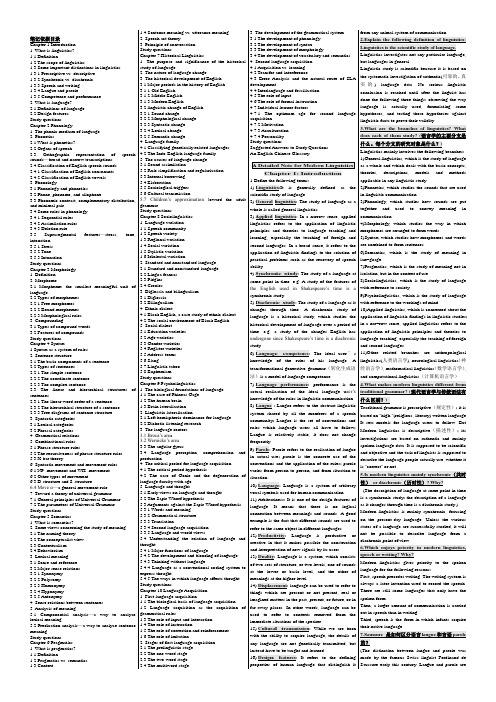
1. What is linguistics?1.1 Definition1.2 The scope of linguistics1.3 Some important distinctions in linguistics1.3.1 Prescriptive vs. descriptive1.3.2 Synchronic vs. diachronic1.3.3 Speech and writing1.3.4 Langue and parole1.3.5 Competence and performance2. What is language?2.1 Definitions of language2.2 Design featuresStudy questionsChapter 2 Phonology1. The phonic medium of language2. Phonetics2.1 What is phonetics?2.2 Organs of speech2.3 Orthographic representation of speech sounds—broad and narrow transcriptions2.4 Classification of English speech sounds2.4.1 Classification of English consonants2.4.2 Classification of English vowels3. Phonology3.1 Phonology and phonetics3.2 Phone, phoneme, and allophone3.3 Phonemic contrast, complementary distribution, and minimal pair3.4 Some rules in phonology3.4.1 Sequential rules3.4.2 Assimilation rules3.4.3 Deletion rule3.5 Suprasegmental features—stress, tone, intonation3.5.1 Stress3.5.2 Tone3.5.3 IntonationStudy questionsChapter 3 Morphology1. Definition2. Morpheme2.1 Morpheme: the smallest meaningful unit of language2.2 Types of morphemes2.2.1 Free morphemes2.2.2 Bound morphemes2.2.3 Morphological rules3. Compounding3.1 Types of compound words3.2 Features of compoundsStudy questionsChapter 4 Syntax1.Syntax as a system of rules2. Sentence structure2.1 The basic components of a sentence2.2 Types of sentences2.2.1 The simple sentence2.2.2 The coordinate sentence2.2.3 The complex sentence2.3 The linear and hierarchical structures of sentences2.3.1 The linear word order of a sentence2.3.2 The hierarchical structure of a sentence2.3.3 Tree diagrams of sentence structure3. Syntactic categories3.1 Lexical categories3.2 Phrasal categories4. Grammatical relations5. Combinational rules5.1 Phrase structure rules5.2 The recursiveness of phrase structure rules5.3 X-bar theory6. Syntactic movement and movement rules6.1 NP- movement and WH- movement6.2 Other types of movement6.3 D-structure and S-structure6.4 Move α—a general movement rule7. Toward a theory of universal grammar7.1 General principles of Universal Grammar7.2 The parameters of Universal GrammarStudy questionsChapter 5 Semantics1. What is semantics?2. Some views concerning the study of meaning2.1 The naming theory2.2 The conceptualist view2.3 Contextualism2.4 Behaviorism3. Lexical meaning3.1 Sense and reference3.2 Major sense relations3.2.1 Synonymy3.2.2 Polysemy3.2.3 Homonymy3.2.4 Hyponymy3.2.5 Antonymy4. Sense relations between sentences5. Analysis of meaning5.1 Componential analysis—a way to analyze lexical meaning5.2 Predication analysis—a way to analyze sentence meaningStudy questionsChapter 6 Pragmatics1. What is pragmatics?1.1 Definition1.2 Pragmatics vs. semantics1.3 Context 1.4 Sentence meaning vs. utterance meaning2. Speech act theory3. Principle of conversationStudy questionsChapter 7 Historical Linguistics1. The purpose and significance of the historicalstudy of language2. The nature of language change3. The historical development of English3.1 Major periods in the history of English3.1.1 Old English3.1.2 Middle English3.1.3 Modern English3.2 linguistic change of English3.2.1 Sound change3.2.2 Morphological change3.2.3 Syntactic change3.2.4 Lexical change3.2.5 Semantic change4. Language family4.1 Classifying genetically related languages4.2 The Indo-English language family5. The causes of language change5.1 Sound assimilation5.2 Rule simplification and regularization5.3 Internal borrowing5.4 Elaboration5.5 Sociological triggers5.6 Cultural transmission5.7 Children’s approximation t oward the adultgrammarStudy questionsChapter 8 Sociolinguistics1. Language variation1.1 Speech community1.2 Speech variety1.3 Regional variation1.4 Social variation1.5 Stylistic variation1.6 Idiolectal variation2. Standard and nonstandard language2.1 Standard and nonstandard language2.2 Lingua francas2.3 Pidgins2.4 Creoles3. Diglossia and bilingualism3.1 Diglossia3.2 Bilingualism4. Ethnic dialect4.1 Black English, a case study of ethnic dialect4.2 The social environment of Black English5. Social dialect5.1 Education varieties5.2 Age varieties5.3 Gender varieties5.4 Register varieties5.5 Address terms5.6 Slang5.7 Linguistic taboo5.8 EuphemismStudy questionsChapter 9 Psycholinguistics1. The biological foundations of language1.1 The case of Phineas Gage1.2 The human brain1.3 Brain lateralization2. Linguistic lateralization2.1 Left hemispheric dominance for language2.2 Dichotic listening research3. The language centers3.1 Broca’s are a3.2 Wernicke’s area3.3 The angular gyrus3.4 Language perception, comprehension andproduction4. The critical period for language acquisition4.1 The critical period hypothesis4.2 The case of Genie and the degeneration oflanguage faculty with age5. Language and thought5.1 Early views on language and thought5.2 The Sapir-Whorf hypothesis5.3 Arguments against the Sapir-Whorf hypothesis5.3.1 Words and meaning5.3.2 Grammatical structure5.3.3 Translation5.3.4 Second language acquisition5.3.5 Language and world views5.4 Understanding the relation of language andthought5.4.1 Major functions of language5.4.2 The development and blending of language5.4.3 Thinking without language5.4.4 Language as a conventional coding system toexpress thought5.4.5 The ways in which language affects thoughtStudy questionsChapter 10 Language Acquisition1. First language acquisition1.1 The biological basis of language acquisition1.2 Language acquisition as the acquisition ofgrammatical rules1.3 The role of input and interaction1.4 The role of instruction1.5 The role of correction and reinforcement1.6 The role of imitation2. Stages of first language acquisition2.1 The prelinguistic stage2.2 The one-word stage2.3 The two-word stage2.4 The multiword stage3. The development of the grammatical system3.1 The development of phonology3.2 The development of syntax3.3 The development of morphology3.4 The development of vocabulary and semantics4. Second language acquisition4.1 Acquisition vs. learning4.2 Transfer and interference4.3 Error Analysis and the natural route ofdevelopment4.4 Interlanguage and fossilization4.5 The role of input4.6 The role of formal instruction4.7 Individual learner factors4.7.1 The optimum age for secondacquisition4.7.2 Motivation4.7.3 Acculturation4.7.4 PersonalityStudy questionsSuggested Answers to Study QuestionsAn English-Chinese Glossaryis generally defined asThe study of language asIn a narrow sense,linguistics refers to the application ofprinciples and theories to language teachinglearning, especially the teaching of foreignsecond languages. In a broad sense, it refersapplication of linguistic findings to the solutionpractical problems such as the recovery ofA study of the featuresthe English used in Shakespeare’s time isA diachronic studylanguage is a historical study, which studiestime. e.g. a study of the changes Englishundergone since Shakespeare’s time is a diachronicThe ideal user’knowledge of the rules of his language.transformational-generative grammar(转化生成语法)is a model of language competence.performance islanguage usby all the members of acommunity; Langue is the set of conventionsrules which language users all have toLangue is relatively stable, it does notin actual use; parole is the concrete use ofvaries from person to person, andLanguage is a system oflanguage. It means that there is noconnection between meanings and sounds. ALanguage is productivemakes possible theLanguage is a system, whichat the lower or basic level, and the otherthings which are present or not present, realfar-away places. In other words, language canused to refer to contexts removed fromWhile we arethe detailsany language are not genetically transmitted,It refers to thethat distinguishFrench words.)Langue refers to the abstract linguistic system shared by all the members of a speech community, and parole refers to the realization of langue in actual use. Langue is the set of conventions and rules which language users all have to follow while parole is the concrete use of the conventions and the application of the rules. Langue is abstract; it is not the language people actually use, but parole is concrete; it refers to the naturally occurring language events. Langue is relatively stable, it does not change frequently; while parole varies from person to person, and from situation to situation. 8.Chomsky的语言能力competence和语言使用performance各指什么?(American linguist N. Chomsky in the late 1950’s proposed the distinction between competence and performance.)Chomsky defines competence as the ideal user’s knowledge of the rules of his language. This internalized set of rules enables the language user to produce and understand an infinitely large number of sentences and recognize sentences that are ungrammatical and ambiguous. According to Chomsky, performance is the actual realization of this knowledge in linguistic communication. Although the speaker’s knowledge of his mother tongue is perfect, his performances may have mistakes because of social and psychological factors such as stress, embarrassment, etc…Chomsky believes that what linguists should study is the competence, which is systematic, not the performance, which is too haphazard (偶然的).9.How is Saussure’s distinction between langue and parole similar to Chomsky’s distinction between competence and performance? And what is their difference?Both Saussure and Chomsky make the distinction between the abstract language system and the actual use of language. Their purpose is to single out one aspect of language for serious study.They differ in that Saussure takes a sociological view of language and his notion of langue is a matter of social conventions, and Chomsky looks at language from a psychological point of view and to him competence is a property of the mind of each individual.10.What characteristics of language do you think should be included in a good, comprehensive definition of language?Language is a system of arbitrary vocal symbols used for human communication.First of all, language is a system, i.e. elements of language are combined according to rules. Second, language is arbitrary in the sense that there is no intrinsic connection between the word and the thing it refers to.Third, language is vocal because the primary medium is sound for all languages.The term “human” is meant to specify that language is human-specific.11.What features of human language have been specified by Charles Hockett to show that it is essentially different from any animal communication system? 人类语言的甄别性特征是什么?1.Arbitrariness(任意性): (课本答案:a sign of sophistication only humans are capable of) It means that there is no logical connection between meanings and sounds. Although language is arbitrary by nature, it is not entirely arbitrary. Non-arbitrary words make up only a small percentage of the total number. The arbitrary nature of language is a sign of sophistication and it makes it possible for language to have an unlimited source of expressions.2.Productivity(创造性): (课本答案:creativity: animals are quite limited in the messages they are able to send)Language is productive or creative in that it makes possible the con¬struction and interpretation of an infinitely large number of sentences, including those they have never said or heard before.3.Duality(二重性): (课本答案:a feature totally lacking in any animal communication)It means that language is a system, which consists of two sets of structure, or two levels, one of sounds at the lower level and the other of meanings at the higher level. At the lower or the basic level, there is the structureof individual and meaningless sounds, which can begrouped into meaningful units at the higher level.This duality of structure or dou¬ble articulation oflanguage enables its users to talk about anythingwithin their knowledge.4.Displacement(移位性): (课本答案:no animalcan “talk”about things removed from theimmediate situation)Language can be used to referto things which are present or not present, real orimagined matters in the past, present, or future, orfar-away places. In other words, language can beused to refer to contexts removed from theimmediate situations of the speaker.5. Cultural transmission(文化传递性):(课本答案:details of human language system are taught andlearned while animals are born with the capacity tosend out certain signals as a means of limitedcommunication)While we are born with the abilityto acquire language, the details of any language arenot genetically transmitted, but instead have to betaught and learned.12.Do you think human language is entirelyarbitrary? Why?Language is arbitrary in nature, it is not entirelyarbitrary, because there are a limited number ofwords whose connections between forms andmeanings can be logically explained to a certainextent, for example, the onomatopoeia, words whichare coined on the basis of imitation of sounds bysounds such as bang, crash, etc.. Take compoundsfor another example. The two elements “photo” and“copy” in “photocopy”are non-motivated, but thecompound is not arbitrary.Chapter 2: Phonology1.Define the terms:1).phonetics: Phonetics is defined as the study ofthe phonic medium of language; it is concerned withall the sounds that occur in the world’ s languages2).auditory phonetics: It studies the speech soundsfrom the hearer’s point of view. It studies how thesounds are perceived by the hearer.3).acoustic phonetics: It studies the speech soundsby looking at the sound waves. It studies thephysical means by which speech sounds aretransmitted through the air from one person toanother.4).international phonetic alphabet [IPA]: It is astandardized and internationally accepted system ofphonetic transcription.5).Broad transcription: the transcription withletter-symbols only, i.e. one letter-symbol for onesound. This is the transcription normally used indictionaries and teaching textbooks.6).Narrow transcription: is the transcription withletter-symbols together with the diacritics. This isthe transcription used by the phoneticians in theirstudy of speech sounds.7).diacritics: is a set of symbols which can be addedto the letter-symbols to make finer distinctions thanthe letters alone make possible.8).Voiceless(清音): when the vocal cords are drawnwide apart, letting air go through without causingvibration, the sounds produced in such a conditionare called voiceless sounds.9).Voicing(浊音): Sounds produced while thevocal cords are vibrating are called voiced sounds.10).Vowel: the sounds in production of which noarticulators come very close together and the airstream passes through the vocal tract withoutobstruction are called vowels.11).Consonants: the sounds in the production ofwhich there is an obstruction of the air stream atsome point of the vocal tract are called consonants.12).phonology: Phonology studies the system ofsounds of a particular language; it aims to discoverhow speech sounds in a language form patterns andhow these sounds are used to convey meaning inlinguistic communication.13).phone: Phones can be simply defined as thespeech sounds we use when speaking a language. Aphone is a phonetic unit or segment. It does notnecessarily distinguish meaning.14).phoneme: a collection of abstract phoneticfeatures, it is a basic unit in phonology. It isrepresented or realized as a certain phone by acertain phonetic context.15).allophone: The different phones which canrepresent a phoneme in different phoneticenvironments are called the allophones of thatphoneme. For example [l] and [l]16).phonemic contrast: Phonemic contrast refers tothe relation between two phonemes. If twophonemes can occur in the same environment anddistinguish meaning, they are in phonemic contrast.17).Complementary distribution: refers to therelation between two similar phones which areallophones of the same phoneme, and they occur indifferent environments.18).minimal pair:When two different forms areidentical in every way except for one sound segmentwhich occurs in the same place in the strings, thetwo words are said to form a minimal pair. Forexample: bin and pin.19).suprasegmental features: the phonemicfeatures that occur above the level of the segmentsare called suprasegmental features. The mainsuprasegmental features include stress, tone andintonation.20).tone: Tones are pitch variations, which arecaused by the differing rates of vibration of thevocal cords. Pitch variation can distinguish meaningjust like phonemes. The meaning-distinctivefunction of the tone is especially important in tonelanguages, for example, in Chinese.21).intonation: When pitch, stress and sound lengthare tied to the sentence rather than the word inisolation, they are collectively known as intonation.For example, English has four basic types ofintonation: the falling tone, the rising tone, thefall-rise tone and the rise-fall tone.2.What are the two major media ofcommunication? Of the two, which one isprimary and why? 语言交际的两大媒介是什么?哪一个是基本的交际媒介?为什么?Speech and writing are the major media ofcommunication. Speech is considered primary overwriting. The reasons are: speech is prior to writingin language evolution, speech plays a greater role indaily communications, and speech is the way inwhich people acquire their native language.3.What are the three branches of phonetics? Howdo they contribute to the study of speech sounds?语音学的三个分支是什么。
英语词汇学串讲4
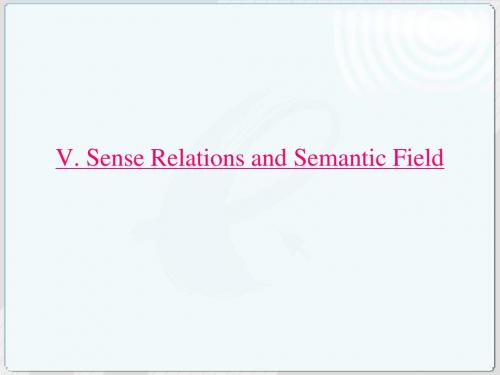
The second principal consideration is semantic relatedness.
In dictionaries, a polysemant has its meanings all listed under one headword whereas homonyms are listed as separate entries.
2005 1. There are two approaches to the study of polysemy. They are____. A. primary and secondary B. central and peripheral C. diachronic and synchronic D. formal and functional 答案:C 48. What is polysemy? Illustrate your points.
E.g. lie: distort the fact(euph)
(4) Coincidence with idiomatic expressions
E.g. help lend one a hand
5.3.3 Discrimination of Synonyms: Difference in denotation,
5.3.1 absolute synonyms and relative synonyms. Absolute synonyms also known as complete synonyms are words which are identical in meaning in all its aspects, i. e. both in grammatical meaning and lexical meaning, including conceptual and associative meanings. Relative synonyms also called near-synonyms are similar or nearly the same in denotation, but embrace different shades of meaning or different degrees of a given quality.
英语词汇学串讲2

3.5. Major and minor word formation processes
affixation
Major processes compounding conversion
D. free morphemes
10. Chiefly found in derived words, bound morphemes include
_________.
A. bound roots
B. inflectional affixes
C. derivational affixes
D. all the above
Criteria of Classifications of suffixation: People group suffixes on a grammatical basis into noun suffixes, verb suffixes, adjective suffixes, etc.
If a suffix is fixed at the end of a verb and derives a noun, then this noun is called deverbal nouns.
Derivational affixes: Derivational affixes are affixes added to other morphemes to
create new words. Derivational affixes can be further divided into prefixes and
自考英语词汇学教案
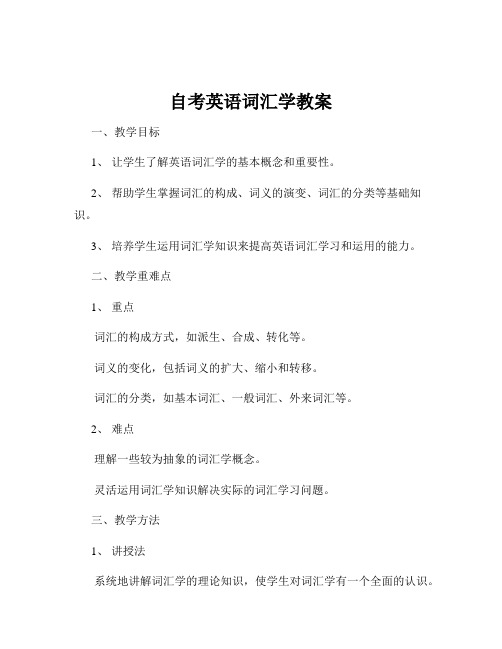
自考英语词汇学教案一、教学目标1、让学生了解英语词汇学的基本概念和重要性。
2、帮助学生掌握词汇的构成、词义的演变、词汇的分类等基础知识。
3、培养学生运用词汇学知识来提高英语词汇学习和运用的能力。
二、教学重难点1、重点词汇的构成方式,如派生、合成、转化等。
词义的变化,包括词义的扩大、缩小和转移。
词汇的分类,如基本词汇、一般词汇、外来词汇等。
2、难点理解一些较为抽象的词汇学概念。
灵活运用词汇学知识解决实际的词汇学习问题。
三、教学方法1、讲授法系统地讲解词汇学的理论知识,使学生对词汇学有一个全面的认识。
2、案例分析法通过实际的词汇例子,帮助学生理解词汇学的概念和规律。
3、练习法布置相关的练习题,让学生巩固所学的知识,提高应用能力。
四、教学过程1、导入(约 10 分钟)同学们,我先给大家讲个事儿。
有一次我去超市买东西,看到一个外国友人在挑选水果,他想要买苹果,但是不知道怎么说,就一直在比划。
旁边的售货员也很着急,不明白他到底想要什么。
最后还是我用英语跟他交流,解决了这个问题。
通过这件事,我就发现啊,掌握足够的英语词汇是多么重要。
而咱们这门英语词汇学,就是要帮助大家更好地理解和掌握英语词汇,让咱们在使用英语的时候更加得心应手。
2、知识讲解(约 40 分钟)(1)词汇学的基本概念解释什么是词汇学,以及它在英语学习中的地位和作用。
举例说明词汇学与日常生活、学习和工作的密切关系。
(2)词汇的构成详细讲解派生、合成、转化这三种主要的构词方式。
比如“unhappy”就是在“happy”前面加上“un”这个前缀构成的,意思就变成了“不开心的”;“classroom”是由“class”和“room”两个单词合成的,就是“教室”的意思;“water”这个词既可以作名词“水”,又可以作动词“浇水”,这就是转化。
(3)词义的演变介绍词义扩大、缩小和转移的概念和例子。
像“bird”这个词,原本指的是“幼鸟”,后来词义扩大,泛指“鸟”;“meat”过去指“食物”,现在词义缩小,只指“肉类”;“coach”最初是“马车”的意思,现在转移为“教练”。
《英语词汇学》串讲笔记2
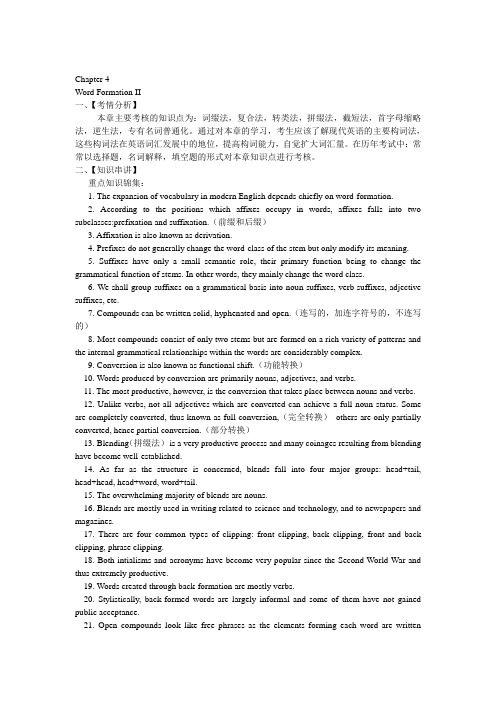
Chapter 4Word Formation II一、【考情分析】本章主要考核的知识点为:词缀法,复合法,转类法,拼缀法,截短法,首字母缩略法,逆生法,专有名词普通化。
通过对本章的学习,考生应该了解现代英语的主要构词法,这些构词法在英语词汇发展中的地位,提高构词能力,自觉扩大词汇量。
在历年考试中:常常以选择题,名词解释,填空题的形式对本章知识点进行考核。
二、【知识串讲】重点知识锦集:1. The expansion of vocabulary in modern English depends chiefly on word-formation.2. According to the positions which affixes occupy in words, affixes falls into two subclasses:prefixation and suffixation.(前缀和后缀)3. Affixation is also known as derivation.4. Prefixes do not generally change the word-class of the stem but only modify its meaning.5. Suffixes have only a small semantic role, their primary function being to change the grammatical function of stems. In other words, they mainly change the word class.6. We shall group suffixes on a grammatical basis into noun suffixes, verb suffixes, adjective suffixes, etc.7. Compounds can be written solid, hyphenated and open.(连写的,加连字符号的,不连写的)8. Most compounds consist of only two stems but are formed on a rich variety of patterns and the internal grammatical relationships within the words are considerably complex.9. Conversion is also known as functional shift.(功能转换)10. Words produced by conversion are primarily nouns, adjectives, and verbs.11. The most productive, however, is the conversion that takes place between nouns and verbs.12. Unlike verbs, not all adjectives which are converted can achieve a full noun status. Some are completely converted, thus known as full conversion,(完全转换)others are only partially converted, hence partial conversion.(部分转换)13. Blending(拼缀法)is a very productive process and many coinages resulting from blending have become well-established.14. As far as the structure is concerned, blends fall into four major groups: head+tail, head+head, head+word, word+tail.15. The overwhelming majority of blends are nouns.16. Blends are mostly used in writing related to science and technology, and to newspapers and magazines.17. There are four common types of clipping: front clipping, back clipping, front and back clipping, phrase clipping.18. Both intialisms and acronyms have become very popular since the Second World War and thus extremely productive.19. Words created through back-formation are mostly verbs.20. Stylistically, back-formed words are largely informal and some of them have not gained public acceptance.21. Open compounds look like free phrases as the elements forming each word are writtenseparately.22. As a rule, the stress of compounds falls on the first element.23. A compound functions as a single grammatical unit, so the internal structure can not be changed.24. Conversion(转换法)refers to the use of words of one class as that of a different class.25. Partial conversion and full conversion are concerned with adjectives when converted to nouns.名词解释:1. affixation(词缀法): Affixation is generally defined as the formation of words by adding word-forming or derivational affixes to stems.2. prefixation(前缀法): Prefixation is the formation of new words by adding prefixes to stems.3. suffixation(后缀法): Suffixation is the formation of new words by adding suffixes to stems.4. compounding(合成法): Compounding, also called composition, is the formation of new words by joining two or more stems. Words formed in this way are called compounds.5. conversion(转换法): Conversion is the formation of new words by converting words of one class to another class.6. blending(拼缀法): Blending is the formation of new words by combining parts of two words or a word plus a part of another word. Words formed in this way are called blends or pormanteau words.7. clipping(截短法): Another common way of making a word is to shorten a longer word by cutting a part off the original and using what remains instead. This is called clipping.8. acronymy(首字母拼音法): Acronymy is the process of forming new words by joining the initial letters of names of social and political organizations or special noun phrases and technical terms.9. initialisms(首字母缩略词): Initialisms are words pronounced letter by letter.10. acronyms(首字母拼音词): Acronyms are words formed from initial letters but pronounced as a normal word.11. back-formation(逆生法): Back-formation is considered to be the opposite process of suffixation. It’s therefore the method of creating words by removing the supposed suffixes.论述问答题:1. In what aspects do compounds differ from free phrases?答:Compounds differ from free phrases in the following three aspects:1). Phonetic features. In compounds the word stress usually occurs on the first element whereas in noun phrases the second element is generally stressed if there is only one stress.2). Semantic features. Compounds are different from free phrases in semantic unity. Every compound should express a single idea just as one word.3). Grammatical features. A compound tends to play a single grammatical role in a sentence, for example, a verb, a noun, or an adjective.2. What is the best way to classify prefixes? Why?答:Prefixes do not usually change the word-class of the stem but only modify lts meaning. Although present-day English finds an increasing number of class-changing prefixes, they make up only an insignificant number in the huge contemporary vocabulary. It might be the best way to classify prefixes by their non-class-changing feature.3. In what way are compound verbs generally formed? Give examples to illustrate your point.答:Compound verbs are created either through conversion or back-formation. This could be illustrated by two words, nickname and chain-smoker. Nickname, which is originally a noun, can be used as a verb through conversion. Chain-smoker, which is originally a noun, can turn into a verb through back-formation.4. What is the difference between partial and full conversion? Explain them with examples. 答:When converted to nouns, not all adjectives can achieve a full noun status. Some are completely converted, thus known as full conversion, others are only partially converted, hence partial conversion. When a noun fully converted from an adjective has all the characteristics of a noun, it can take an indefinite article or-(e)s to indicate singular or plural number. For example, adjective “white”can be fully converted to a noun “white”, which can take indefinite article: a white. When a noun partially converted from adjectives do not possess all the qualities a noun does. They must be used together with the definite article, and they retain some of the adjective features. For example, the poor, the rich.5. Both back-formation(逆生法)and back-clipping(截后留前)are ways of making words by removing the endings of words. How do you account for the coexistence of the two? Can you explain the difference?答:Back-formation is the method of creating words by removing the supposed suffixes. It’s considered to be the opposite process of suffixation. For example, “loafer”may be assumed to derive from the verb “loaf”’on the analogy of known derivatives, such as “swimmer” from “swim” or “driver” from “drive”. By removing the supposed suffixes –er from “loafer”, a verb “loaf”‟is coined. Majority of back-formed words are verbs. Back-clipping is different. The deletion occurs at the end of the word(usually a noun). Both the original long word and its short form remain in the same word class. In diffe rent context, one could be used in other‟s place.6. After he comes back, he oiled machine.In above sentence, which word is the converted word? Explain the type of the conversion and the effect of the conversion.答:In this sentence, the word “oil”is the converted word. It is converted from a noun to a verb. When it was used as a noun, the meaning of it is that “油”. But in this sentence, it was used as a verb, the meaning is “给…加油”; As is often the case, a noun can be converted to a verb without any change. The use of the verb converted is both economical and vivid.Chapter 5Word Meaning一、【考情分析】本章主要考核的知识点为:“意义”的意义,词义的理据,词义的类别。
英语词汇学考前串讲
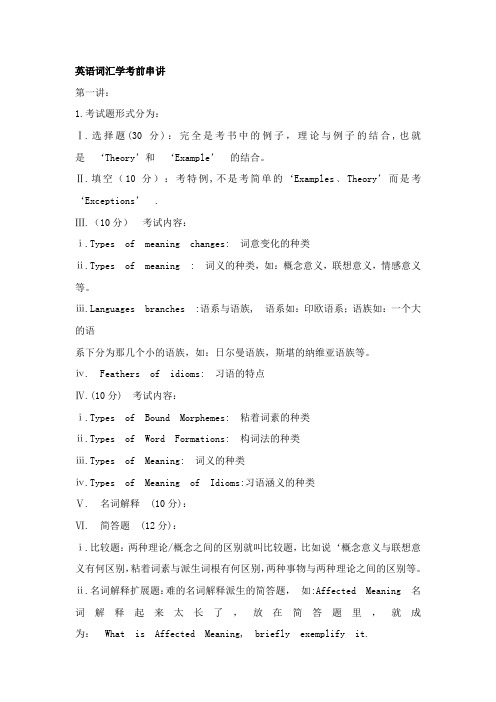
英语词汇学考前串讲第一讲:1.考试题形式分为:Ⅰ.选择题(30分):完全是考书中的例子,理论与例子的结合,也就是‘Theory’和‘Example’的结合。
Ⅱ.填空(10分):考特例,不是考简单的‘Examples﹑Theory’而是考‘Exceptions’.Ⅲ.(10分)考试内容:ⅰ.Types of meaning changes: 词意变化的种类ⅱ.Types of meaning : 词义的种类,如:概念意义,联想意义,情感意义等。
ⅲ.Languages branches :语系与语族, 语系如:印欧语系;语族如:一个大的语系下分为那几个小的语族,如:日尔曼语族,斯堪的纳维亚语族等。
ⅳ.Feathers of idioms: 习语的特点Ⅳ.(10分) 考试内容:ⅰ.Types of Bound Morphemes: 粘着词素的种类ⅱ.Types of Word Formations: 构词法的种类ⅲ.Types of Meaning: 词义的种类ⅳ.Types of Meaning of Idioms:习语涵义的种类Ⅴ.名词解释(10分):Ⅵ.简答题(12分):ⅰ.比较题:两种理论/概念之间的区别就叫比较题,比如说‘概念意义与联想意义有何区别,粘着词素与派生词根有何区别,两种事物与两种理论之间的区别等。
ⅱ.名词解释扩展题:难的名词解释派生的简答题,如:Affected Meaning 名词解释起来太长了,放在简答题里,就成为:What is Affected Meaning, briefly exemplify it.ⅲ.Optional:可考可不考的题,往往是给出名词让你举例子Ⅶ.分析题(18分):给出例子,让你用理论加以分析。
二. 串讲内容:Introduction 部分:Lexicology 这门课算哪一种学科的分支:Lexicology is a branch of linguistics.Lexicology和那些重要的学科建立了联系:1)Morphology 2) Semantics 3) Stylistics 4) Etymology 5) Lexicography研究lexicology 的两大方法:1) Diachronic approach : 历时语言学2) Synchronic approach : 共时语言学. wife纵观历时语言学的方法论,woman 词义的变化算是词义变化的哪一种模式Woman 的词义的变化算Narrowing or specialization第一章部分:What is word词具有哪些特点词的特点也就是对词的名词解释。
《英语词汇学》串讲笔记3

《英语词汇学》串讲笔记3Chapter 7Changes in Word Meaning一、【考情分析】本章主要考核的知识点为:词义变化的种类,词义变化的原因。
通过对本章的学习考生应该了解词义变化的必然性,词义变化的主要方式和原因。
在历年考试中:常常以选择题,填空题,搭配题和名词解释题的形式对本章知识点进行考核。
二、【知识串讲】重点知识锦集:1. Extension(词义扩大) of meaning is also known as generalization.2. Narrowing of meaning is also called specialization.3. Of the modes of word-meaning change, extension and narrowing are by far the most common.4. Degradation(降格)or pejoration of meaning is the opposite of semantic elevation.5. The degraded meaning “sexual desire ”of the word “lust ”comes from its old meaning“ pleasure”.6. The name given to the widening of meaning which some words undergo is extension.7. There are generally two major factors that cause changes in meaning: Extra-linguistic Factorsand Linguistic Factors.(非语言因素和语言因素)8. The attitudes of classes have made inroads into lexical meaning in the case of elevation ordegradation.9. The changes of meaning may be caused by internal factors within the Language system.10. The meanings of “lip” and “tongue”in “the lip of a wound”and “the tongue of a bell”have experienced associated transfer.(联想转移)11. The so-called “King’s English” serves as a class reason (阶级原因) in word-meaningchange.12. The change of word-meaning is brought about by following internal factors: the influx ofborrowing, shortening, analogy.13. Generalization is a process by which a word that originally had a specialized meaning has nowbecome generalized.14. The four major modes of semantic change are: extension (扩大), narrowing(缩小), elevation(升华) and degradation(降格).名词解释:1.extension(词义的扩大): It is a process by which a word which originally had a specializedmeaning has now become generalized. In other words,the term has extended to cover a broaderand often less definite concept.2.narrowing(词义的缩小): it is the opposite of widening meaning. It is a process by which aword of wide meaning acquires a narrower or specialized sense. In other words, a word whichused to have a more general meaning becomes restricted in its application and conveys a specialmeaning in present-day English.3.elevation(升华): Elevation or amelioration refers to the process by which words rise fromhumble beginnings to positions of importance.4. degradation(降格): Degradation or pejoration of meaning is the opposite of semantic elevation.It’s a process whereby words of good origin fall into ill reputation or non-affective words come tobe used inderogatory sense. 5. transfer(转移): Words which were used to designate one thing but later changed to mean something else have experienced the process of semantic transfer.论述问答题:1.What are the linguistic factors(语言因素) that have caused the changing of meaning? Try toexplain it.答:Linguistic Factors that have caused the changing of meaning cover four:1) One type of such change occurs when a phrase is shortened to one word which retains themeaning of the whole。
- 1、下载文档前请自行甄别文档内容的完整性,平台不提供额外的编辑、内容补充、找答案等附加服务。
- 2、"仅部分预览"的文档,不可在线预览部分如存在完整性等问题,可反馈申请退款(可完整预览的文档不适用该条件!)。
- 3、如文档侵犯您的权益,请联系客服反馈,我们会尽快为您处理(人工客服工作时间:9:00-18:30)。
Archaisms:words or forms that were once in common use but are now restricted only to specialized or limited use. They are found mainly in older poems, legal documents and religious writing or speech . E.g. quoth(said)
1.5.6 Borrowed Words
Words taken over from foreign languages are known as borrowed words or loan words or borrowings in simple terms. According to the degree of assimilation and manner of borrowing, we can bring the loan-words under four classes. (1) Denizens. E.g. pork (2)Aliens. E.g. kowtow (3)Translation-loans. E.g. long time no see ,tea (4) Semantic-loans 出题形式:选择, 填空,定义,搭配,简答 . 2005(42) Borrowed Words
1.5. Classification of Words
• by use frequency: basic word stock and nonbasic vocabulary, • by notion: content words and functional words • by origin: native words and borrowed words. 出题形式:选择, 填空 2006 12.Words can be classified according to the following criteria EXCEPT _________. A. notion B. use frequency C. foundation D. origin 答案:C.
1.3. Sound and Form
English sound is an imperfect representation of the spoken form. (1) in English there are more phonemes than letters. (2) The pronunciation has changed more rapidly than spelling over the years. (3) Some of the differences were created by the early scribes. (4) The borrowing is an important channel of enriching the English vocabulary.
1.5.1 Basic Word Stock The basic word stock is the foundation of the vocabulary accumulated over centuries and forms the common core of the language. Five obvious characteristics: • (1)All national character • (2)Stability. • (3)Productivity. • (4)Polysemy. • (5)Collocability 出题形式:选择, 填空,定义,搭配 2004(8),2003(19)
1.5.2 Nonbasic Vocabulary They include the following: terminology, jargon, slang, argot, dialectal words, archaisms, neologisms. Terminology:technical terms used in particular disciplines and academic areas E.g. penicillin
Content words denote clear notions and thus are known as notional words. Content words, which constitute the main body of the English y, are numerous, and the number is ever growing. They include nouns, verbs, adjectives, adverbs and numerals. E.g. earth, cloud, run, walk
出题形式:填空,选择
2006年 13. Which of the following is NOT correct? ______ A. A word is a meaningful group of letters. B. A word is a unit of meaning. C. A word is a sound or combination of sounds. D. A word is a form that cannot function alone in a sentence. 答案 D 2004年 20. According to semanticists, a word is a unit of ______. 答案:meaning
Argot:the jargon of criminals. Its use is confined to the subcultural groups, and outsiders can hardly understand it. E.g. dip(pick-pocket)
Dialectal words:words used only by speakers of the dialect in question E.g. beauty(AusE=excellent )
词 汇 学
Lexicology
一、题型和考点分布 二、重点、考点串讲 三、应试、答题技巧
I. Basic Concepts of Word and Vocabulary
1.1. Word
A word is a minimal free form of a language that has a given sound and meaning and syntactic function. (1)a minimal free form of a language (2)a sound unity (3)a unit of meaning (4)a form that can function alone in a sentence.
Neologisms: newly-created words or expressions, or words that have taken on new meanings. E.g. internet 出题形式:选择, 填空,定义,搭配 . 2003(44) jargon
1.5. 3 Content Words
1.2. Sound and Meaning
The relation between sound and meaning is not logical,
but arbitrary and conventional.
Woman (English) Frau ( German) femme (French ) funu ( Chinese) 出题形式:填空,选择和举例说明. 2002年 18.The relationship between sound and meaning is arbitrary or ______________. 答案:conventional
Slang:the sub-standard language, a category that seems to stand between the standard general words including informal ones available to everyone and in-group words like cant(shoptalk of any sub-group), jargon, and argot, all of which are associated with, or most available to, specific groups of the population. E.g. Grass for marijuana(大麻)
出题形式:选择, 填空,定义。
2002年
9.The term "vocabulary" is used in different ways because of all the following reasons EXCEPT that( )
A. it can refer to the common core of a language B. it can refer to the total number of the words in a language C. it can represent all the words used in a certain historical period D. it can stand for words in given dialect or field 答案:A
1.5.4 Functional Words
Functional words do not have notions of their own. Therefore, they are also called empty words. As their chief function is to express the relation between notions, the relation between words as well as between sentences, they are known as form words. Prepositions, conjunctions, auxiliaries and articles belong to this category. E.g. on, of, upon 出题形式:选择, 填空,定义,简答 . 2004(42) functional words
